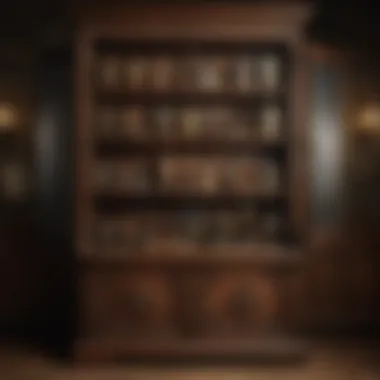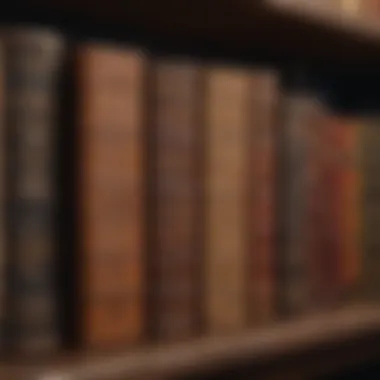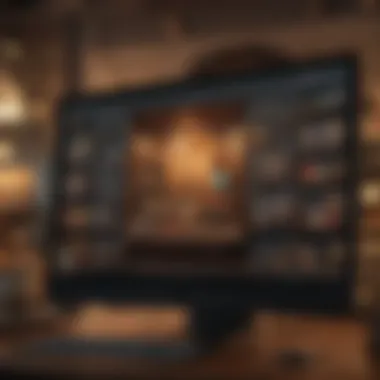Navigating the World of Online Antique Shopping


Intro
In an age where everything seems to be just a click away, the world of antiques has taken a leap into the digital realm. The allure of finding a unique piece, often rich in history and character, remains strong. Online antique sites are not just platforms for trading goods; they embody a bridge between history and contemporary shopping habits. The essence of this guide is to navigate through this exciting world, enabling collectors, enthusiasts, and the simply curious to appreciate and indulge in antique shopping like never before.
Understanding the significance of these online marketplaces is crucial. They offer an array of collectibles that transcend geographical boundaries, bringing together sellers and buyers from different parts of the globe. But, this journey isn’t without its own twists and turns; the potential for discovering remarkable treasures also comes with the challenge of discerning authenticity and value.
This guide aims to delve into the intricacies of online antique sites, exploring their evolution, unique features, and what sets one platform apart from another. We will also arm you with essential tips for effective collecting, while highlighting the opportunities and challenges the industry faces in an increasingly digital landscape. In the end, we will look forward, considering the trends shaping the future of antique shopping and how the preservation of history is intertwined with the advancements in technology.
Join us as we embark on this comprehensive journey, designed not only for seasoned collectors but also for anyone with a passion for historical pieces that tell compelling stories.
Intro to Antique Sites
In an era dominated by rapid technological advancements, the realm of antiques has not escaped this tide of change; indeed it has embraced it wholeheartedly. This introduction to antique sites serves as a compass in an increasingly complex landscape where history and modernity converge. \n\nAntiques are more than just items from the past; they are vessels of cultural narratives, holding stories that can transport us back in time. As we navigate through life, engaging with these objects allows us to preserve legacies and appreciate craftsmanship. Collectors, designers, and enthusiasts increasingly recognize the vital role that online platforms play in this journey.
Definition and Importance of Antiques
Antiques are typically defined as artifacts that are at least 100 years old. They are distinguished by their craftsmanship, historical significance, and the unique narratives they tell. Their importance lies not only in aesthetic appeal but also in their ability to connect us with bygone eras. Collectors often seek antiques not just for their monetary value but for the personal stories and memories they evoke.
Moreover, owning an antique allows one to participate in a larger conversation about history and heritage. By integrating these objects into modern spaces, collectors create environments that marry the old with the new—each piece offering authenticity and context in an increasingly homogenized world.
The Digital Transformation of Antique Shopping
The shift from brick-and-mortar antique shops to online marketplaces has radically transformed how collectors access and curate their collections. Previously, finding unique pieces required physical exploration of various shops, flea markets, and estate sales, which could be laborious and time-consuming. Now, with the click of a button, countless inventory options are at one's fingertips.
This transition has also democratized the antique shopping experience. Collectors from all corners of the globe can now access rare items that may have once been confined to a specific locale. Digital platforms serve as a gallery that transcends geographical boundaries, housing eclectic inventories that cater to various tastes and preferences.
Key benefits of this transformation include:
- Wider Selection: A plethora of items from different geographic areas available in a single place.
- Convenience: Browse and purchase antiques from the comfort of one's own home, saving time and energy.
- Community Building: Online forums and social media allow enthusiasts to connect, share insights, and celebrate their findings.
However, it is essential to approach online antique shopping with a discerning eye, as the digital realm, while rich in potential, poses its challenges. The importance of being vigilant about authenticity, sourcing, and seller reliability cannot be overstated as the allure of online antiques continues to captivate many.
Historical Context of Antiques Online
The journey of antiquities, from hidden treasures in dusty attics to modern-day ecommerce, paints a fascinating picture of how society has evolved in its appreciation for the past. This historical context is not just a backdrop; it informs our understanding of what antiques mean today in an interconnected world. The transition of antique shopping from brick-and-mortar establishments to online platforms has reshaped the landscape entirely, providing both enthusiasts and casual collectors with unprecedented access to their passions. This shift is vital for grasping how antiques are marketed, sold, and valued today.
From Brick-and-Mortar to Online Platforms
The early days of antique buying primarily revolved around local shops or antique fairs. You would scratch the surface of a quaint store, feeling the history wrapped within the aged wood or chipped porcelain. But, as the internet began to weave itself into our daily lives, the way we buy and sell antiques transformed almost overnight. Large chains and small shops alike faced increasing pressure to adapt or risk becoming irrelevant.
Key Changes:
- Accessibility: Now, anyone can explore the world of antiques from the comfort of their sofa, irrespective of location. A lively market in Paris can be perused just as easily as a small-town shop in Iowa.
- Additional Options: Buyers have access to a much broader range of items than they ever budged before. Whether seeking fine art, vintage furniture, or collectible knickknacks, the options are nearly limitless.
- Vast Resources: With a few clicks, one can research an item's value, provenance, and history, all of which adds depth to each purchase.
This digital evolution carries an essential implication: knowing the origin and journey of an item is crucial. As online platforms allow for immediate, global transactions, it becomes all the more imperative for collections to be well-documented and authentic.
Key Milestones in Online Antique Sales
The progress of online antique sales has been characterized by several key milestones that reflect broader trends in technology and consumer behavior:
- Ebay and the Rise of Auctions: Launched in 1995, eBay began to cater to a growing demographic eager to sell and purchase unique collectibles. The auction format created excitement and competition in the market.
- The Specialization of Online Platforms: Following eBay's success, dedicated antique marketplaces like Ruby Lane took shape. They focused exclusively on antiques and collectibles, offering sellers a more targeted platform to reach prospective buyers.
- Social Media Integration: Platforms like Instagram and Facebook began showcasing antique dealers and their wares, while offering marketplaces for niche auctions and curated sales events. The rise of social commerce has made it possible for collectors to engage directly with sellers, creating a more community-driven approach to antique shopping.
- Mobile Accessibility: The proliferation of smartphones has made online antique shopping as easy as a quick swipe. Many platforms now have dedicated apps, vital for busy professionals. This ease of use has stimulated sales and drawn in both seasoned collectors and newcomers to the fold.
- Ethical Sourcing Awareness: More buyers are conscious about sourcing and the environmental impact of their purchases. Online platforms are beginning to cater to this need, offering transparent information about the provenance and ethical considerations of the items listed.
Understanding these developments provides invaluable insight into not only how antiques are marketed but also how consumer expectations have evolved, shaping the future of buying and selling antiques online as a whole.
"Antiques serve as a bridge between our past and present, and their value in digital marketplaces reflects cultural heritage and identity."
As we move further into the digital age, the narrative of online antiques will continue to unfold, offering both challenges and opportunities for collectors and dealers alike.
Categories of Online Antique Sites


The landscape of online antique shopping is both rich and diverse, offering various avenues for collectors and enthusiasts to explore. Each category of online antique sites serves a unique purpose and appeals to different segments of the market, making it crucial for collectors to understand these distinctions. By knowing what each category offers, one can navigate the digital world of antiques with greater ease and confidence.
Marketplace Platforms
Marketplace platforms are akin to bustling online bazaars where many sellers display their wares. Sites like eBay and Etsy attract a multitude of vendors, each offering an array of antiques, ranging from vintage jewelry to classic furniture. The strength of these platforms lies in their vast selection and the ability to compare items from different sellers quickly.
- Accessibility: Because these platforms cater to a broad audience, they often feature a wide range of price points. This accessibility is a double-edged sword; while one can snag a great deal, it also means that quality can vary significantly.
- User Reviews: Another major aspect is the feedback system. Buyers can read reviews and see ratings on sellers, providing an extra layer of assurance before making a purchase.
- Diverse Selection: Whether you’re after a mid-century modern chair or an antique Persian rug, these platforms offer an extensive selection, sometimes more than you could find in a brick-and-mortar store.
Marketplace platforms provide ease and variety, making them a popular choice for collectors who appreciate both novelty and bargains.
Specialized Antique Auctions
Specialized antique auctions represent a more curated approach to the antique buying experience. Platforms like Sotheby’s and Bonhams focus on high-value items, often attracting seasoned collectors and investors. The excitement of bidding can be palpable, but it’s a game best played with some level of skill and knowledge.
- Expertise and Curation: Auctions frequently feature carefully vetted pieces that come with detailed provenance. This enhances the trust factor, appealing to collectors who prioritize authenticity.
- Bidding Dynamics: Understanding how to navigate bids can be a challenge. Prospective buyers must research items, set limits, and remain alert during the auction. Often, the thrill of competition and the allure of securing a rare piece are what draw people to specialized auctions.
- Higher Risks, Greater Rewards: The potential for heightened stakes exists in this category. While one may pay a premium, the chance of acquiring a one-of-a-kind item can often justify the risks involved.
Curated Antique Boutiques
Curated antique boutiques offer a refined shopping experience, focusing on quality over quantity. Sites like Chairish and 1stdibs feature carefully selected items, where each piece tells a story. These boutiques often cater to the high-end market, making them especially attractive to those seeking luxurious and unique finds.
- Tailored Experience: Unlike broader marketplaces, curated boutiques often employ expert curators who choose pieces based on aesthetic and historical significance. For the discerning buyer, this means accessing a collection that embodies a certain sense of style and exclusivity.
- Personalized Service: Many of these boutiques offer personalized customer service, sometimes even providing consultations. This approach adds a personal touch that can enrich the shopping journey.
- Storytelling: Each item comes with its own narrative, allowing collectors to appreciate not just the object but the history behind it. This storytelling aspect enriches the overall experience.
Purchasing from curated boutiques is like stepping into a gallery where every piece has been thoughtfully selected, making it an ideal environment for high-end collectors.
Collecting antiques online is not just about acquiring objects; it's about connecting with history and enjoying the narrative woven into each piece.
In summary, knowing the various categories of online antique sites equips collectors with the understanding needed to make informed decisions. Whether one seeks the spontaneity of a marketplace, the excitement of auctions, or the exclusivity of curated boutiques, each avenue offers distinct benefits that can enhance the joy of collecting.
Features of Quality Antique Sites
When it comes to online antique shopping, not all platforms are created equal. As collectors and enthusiasts, you need to have a keen eye for what makes a site reliable, secure, and enjoyable. This section dives into the vital features that distinguish quality antique sites from the rest. These features not only enhance your shopping experience but also help protect your investments.
User Experience and Navigation
User experience (UX) is paramount in the realm of online antique shopping. A well-designed site ensures ease of navigation, allowing you to quickly find what you're looking for without frustration. Think of it like this: if you have to wrestle with a website just to locate a vintage vase, you’re likely to click away, missing out on a potential treasure.
Factors that contribute to user experience include:
- Intuitive Layout: The site should have categories and filters that make sense. Browsing through furniture? There should be options like "Mid-Century Modern" or "Victorian" right at your fingertips.
- Search Functionality: A robust search bar that understands synonyms or includes auto-suggests can save precious time. If you’re searching for "art deco chairs," but spell it "artdeco chirs," it should still pull up the right items.
- Mobile Accessibility: With many people using smartphones and tablets, a mobile-friendly design is a huge plus. You shouldn't need a magnifying glass to view details on your phone.
In essence, a user-friendly site invites you to explore rather than annoys you.
Authentication and Verification Processes
Antique shopping online brings about a fair share of risks, especially regarding authenticity. The last thing you want is to acquire a so-called "antique" that’s nothing more than a cheap reproduction. Quality antique sites tackle this issue head-on by employing robust authentication and verification methods.
Key practices to look for include:
- Provenance Documentation: A reputable site should provide the history of the item, detailing its origins and previous ownership. This not only enhances the item's value but also builds trust between you and the seller.
- Third-Party Certifications: The presence of certifications from recognized experts or institutions can further substantiate an item’s authenticity, like those granted by Sotheby's or Christie's.
- Return Policies Based on Verification: Reliable sites offer guarantees for the authenticity of their pieces. Should any discrepancies arise, proactive return policies protect you and your investment.
As a buyer, being presented with ample information about the authenticity of your potential purchases allows you to make informed decisions.
Customer Support and After-Sales Service
Navigating the world of antiques isn't always smooth sailing. You might have questions, need clarifications, or even face issues post-purchase. This is where top-notch customer support and after-sales service come into play. Quality antique sites understand that the relationship extends beyond the sale.
Important aspects include:
- Responsive Communication: Whether you're reaching out via email, chat, or phone, timely responses are essential. A seller that prioritizes communication will not only enhance your shopping experience but also give you peace of mind.
- Post-Purchase Assistance: Consider scenarios where you might require help after acquiring your item. Whether it’s about care, maintenance, or assistance with delivery, sites should have systems in place to support you.
- Feedback Mechanisms: Providing options for customers to share their experiences fosters trust and transparency. Consistently good reviews or customer testimonials are a good sign of a site's reliability.


In summary, customer support isn't just about answering the phone; it’s about ensuring you feel valued, informed, and satisfied with your investment.
Quality antique sites are like trustworthy friends—reliable, supportive, and there for you when you need them.
By focusing on user experience, authentication processes, and customer support, you’ll navigate the antique market with confidence, ensuring each piece you choose not only tells a story but also stands the test of time.
Navigating Online Antique Marketplaces
The digital landscape has transformed antique shopping from a niche hobby into an accessible pursuit for many collectors. Navigating online antique marketplaces is essential for making educated purchases and discovering unique pieces. With countless platforms sprouting like wildflowers, each with its quirks and offerings, the ability to maneuver through them can mean the difference between uncovering a gem or falling prey to a mirage.
How to Identify Quality Listings
Identifying quality listings can feel like searching for a needle in a haystack. However, there are several key indicators that can streamline your hunt. When perusing online antiques, pay attention to:
- Detailed Descriptions: Authentic listings often contain comprehensive details about the item, including its history, craftsmanship, and dimensions. If a description feels half-hearted or lacks specifics, think twice.
- High-Quality Images: Pictures should be high-resolution, showing the item from multiple angles. Beware of listings with blurry or overly edited photos, as they often conceal flaws.
- Seller Reputation: Check seller reviews and ratings. Reliable sellers typically have positive feedback and a record of delivering quality items.
- Return Policy: A robust return policy can indicate confidence from the seller. If they allow you to return the item, it speaks volumes about their trust in their merchandise.
Through these elements, you can sift the wheat from the chaff, ensuring that the items you move forward with are sound investments in both quality and price.
Bidding Strategies in Online Auctions
Online auctions can be thrilling, but they also require a calculated approach. To navigate these platforms effectively, consider these strategies:
- Set a Budget: Determine how much you're willing to spend before the auction begins. This prevents impulse buying, which can lead to regret down the road.
- Research Current Prices: Familiarize yourself with recent sales of similar pieces. This knowledge is invaluable and helps you avoid overbidding in the heat of the moment.
- Watch for Patterns: Some sellers have unique bidding patterns. Do they typically start low or near the market value? Observing these habits can help guide your bidding strategy.
- Bid Sniping: If you're feeling particularly bold, consider the endgame. Timing your bid in the last seconds can sometimes win you the item before another bidder can react. Just make sure to have your maximum bid ready.
Armed with these strategies, you'll feel more at home while engaging in the online auction wilderness.
Making Secure Transactions
In an age rife with digital transactions, ensuring the security of your purchases is paramount. Here are critical considerations:
- Secure Payment Methods: Opt for platforms that offer secure payment gateways. PayPal and credit cards typically provide buyer protection, which is crucial when purchasing expensive antiques.
- Check SSL Certificates: Before entering sensitive information, observe the URL. It should start with "https://" and display a padlock icon, indicating a secure connection.
- Avoid Wire Transfers: They may seem convenient, but wire transfers lack buyer protection. Stick to methods that offer recourse if something goes awry.
- Private Seller Precautions: If dealing directly with a private seller, ensure they have credible feedback from other buyers. Consider using escrow services for high-value items to safeguard both parties.
By prioritizing secure transactions, you'll be better equipped to navigate the often murky waters of online antique shopping, making your experience enjoyable and safe.
Challenges in Online Antique Shopping
While the digital age offers golden opportunities for antique enthusiasts, navigating online antique shopping comes with its own set of hurdles. Understanding these challenges is crucial for collectors and shoppers to ensure they engage confidently and effectively in the marketplace. The sheer variety of platforms can sometimes mask the underlying risks, necessitating a deeper dive into potential pitfalls.
Risks of Fraud and Misrepresentation
The thrill of finding a stunning piece to add to your collection often comes with a shadowy aspect—the risk of fraud. With antique sites sprouting like mushrooms after the rain, not everyone plays by the rules. Sellers might misrepresent the condition of an item, inflate its provenance, or pass off reproductions as originals.
Some red flags to watch for include:
- Too-good-to-be-true pricing: If a rare item is listed significantly below market value, it might be worth a second glance.
- Vague or poor-quality photographs: When pictures do not adequately capture an item's details, it can signify an attempt to hide flaws.
- Lack of verifiable information: If the seller can’t provide provenance documentation or detailed descriptions, that’s a warning sign.
"Education is your best weapon against dishonesty in the antique market—research the item as much as possible before buying."
Shipping and Handling Concerns
Once you've made a purchase, the journey for that precious item is not yet over. Shipping and handling of antiques require caution as these objects demand special care.
There are a few considerations here:
- Fragility of items: Antiques can be delicate and require customized packing materials to prevent damage during transit.
- Insurance coverage: Not every seller offers seamless shipping insurance, raising concerns if something goes awry en route.
- Customs and delays: If you’re buying from overseas, customs can add time and additional fees to your purchase. Ensure you know what to expect regarding delivery timelines.
Returns and Refund Policies
Navigating return and refund policies in the world of online antiques can feel like walking a tightrope. Some sellers provide straightforward policies, while others keep their terms as murky as a foggy morning.


Consider these vital aspects:
- Clarity of return conditions: Are items returnable if they don’t match their description? Understand the terms thoroughly before making a purchase.
- Time limits for returns: Many online sites impose strict deadlines—often less than a week—so don’t delay your evaluation after arrival.
- Refund processes: Evaluate whether refunds are given in the form of store credit or back to your original payment method.
By easing into the digital antique trade with an awareness of these challenges, you pave the way for a more informed and satisfying scouring experience. With a little vigilance, those aged treasures can find a place in your home without a hitch.
The Role of Community in Online Antiquing
Online antiquing is not just about buying and selling; it's also about the discussions, connections, and networks formed within the collector community. The importance of this community cannot be overstated, as it provides a platform for sharing knowledge, experiences, and insights. Whether you're a seasoned collector or a novice eager to dive into this wonderful world, engaging with others can enhance your understanding and appreciation of antiques.
Communities focused on antiques foster a sense of belonging and shared passion. Collectors can exchange tips about specific items, debate trends, or simply share their latest finds. This interaction not only enriches individual experiences but also cultivates a deeper respect for the history behind each piece. In many ways, these connections create a living tapestry of knowledge that helps maintain the integrity of antiquing.
Forums and Discussion Groups
A significant part of the antique community operates through online forums and discussion groups. These are spaces where enthusiasts can freely interact, ask questions, and seek advice. Popular platforms like Reddit or specialized antique collector forums host vibrant conversations that can guide new collectors.
- Knowledge Sharing: Members can benefit from the collective expertise of others. Questions about authenticity, market value, or restoration techniques are answered by fellow members who may have faced similar challenges.
- Networking Opportunities: Engaging in discussions can lead to fruitful connections. You might meet someone who knows a trustworthy seller or who can provide insights into a specific era or style of antiques.
- Feedback on Purchases: Before making big-ticket purchases, collectors often turn to forums for a second opinion. Previous buyers can weigh in on their experiences, which can be invaluable in avoiding potential pitfalls.
These platforms thus serve as both educational resources and social networks, often blending their functions seamlessly to create a robust community of antique lovers.
Social Media Influence on Antique Collecting
Social media has emerged as a powerful tool for antique collectors. Platforms like Instagram and Facebook have transformed how collectors share their passion and expertise. Through visually rich content and interactive features, these social media networks allow users to engage with a broader audience.
- Visual Storytelling: Collectors can showcase their prized possessions in an aesthetically pleasing format. This visual storytelling enhances appreciation and helps connect with both amateur and seasoned collectors alike.
- Trends and Challenges: Social media is a space for observing trends. Collectors can spot what’s popular or emerging in the market, providing insights into potential investment pieces. Challenges like identifying specific items or discerning fakes can also be discussed.
- Creating Community Events: Many local antique shows or auctions advertise through social media. This allows collectors to gather, discuss, and share their love for antiques in person, strengthening the community bonds that might be only digital otherwise.
Trends Shaping the Future of Online Antiques
The landscape of antique shopping is not static; it is evolving rapidly due to technological advancements and shifts in consumer behavior. Understanding trends that shape the future of online antiques is imperative for collectors and dealers alike. Today, buyers are looking for more than just a beautiful piece; they desire authenticity, connection to history, and a seamless shopping experience. This section delves into key elements transforming the way antiques are traded online, examining the critical aspects of integration of augmented reality and the focus on sustainability and ethical sourcing.
Integration of Augmented Reality
Augmented reality, or AR, is a transformative tool that is making waves in various industries, and antiques are no exception. This technology allows potential buyers to visualize items in their own space before making a purchase. Imagine scrolling through an online marketplace like 1stDibs and being able to see a Victorian-era armchair rendered in your living room, matching your interior’s style perfectly. This innovation bridges the gap between online shopping and the tactile experience traditionally enjoyed at physical antique shops.
AR not only enhances user engagement but also reduces the chances of returns based on misalignment between customer expectations and the actual product. By allowing collectors to interact with items virtually, they gain a sense of ownership and attachment even before the physical acquisition.
Here are several benefits tied to the adoption of augmented reality in the antique sector:
- Enhanced Visualization: Customers can see how an item fits into their home environment, fostering confidence in their purchases.
- Interactive Experience: This technology invites users to engage with antiques in a more profound way, sparking interest and enthusiasm among collectors.
- Competitive Edge: Sellers employing AR can stand out in a crowded marketplace, attracting tech-savvy customers who value modern conveniences.
Sustainability and Ethical Sourcing
As consumers become more aware of environmental and ethical implications tied to their purchases, sustainability is carving a niche in the antique market. Collectors today often prioritize items that come from sustainable sources or boast a traceable provenance. The growing emphasis on ethical sourcing compels dealers to provide transparency around the origins of their antiques.
Here’s why sustainability is a burning topic:
- Environmental Consciousness: Antique shopping inherently favors re-use and recycling, thus contributing to reduced waste. As collectors opt for vintage pieces instead of newly manufactured ones, they help combat the throwaway culture.
- Supporting Ethical Practices: Buyers are increasingly holding sellers accountable for their sourcing practices. They want assurance that the items they purchase were obtained legally and ethically, without harming communities or cultures.
- Storytelling: Items with a documented history not only appeal aesthetically but also narratively. When an antique has a rich background, it adds intrinsic value beyond its physical appearance, encouraging collectors to invest in its legacy.
End and Recommendations
In wrapping up this comprehensive exploration of antique sites online, it’s essential to reflect on the myriad of elements and benefits discovered throughout the article. The world of online antique shopping is not just a passing fad but a significant transformation in how collectors and enthusiasts engage with historical artifacts.
The recommendations provided are tailored specifically for discerning buyers looking to make informed decisions in the vibrant yet complex online market. For instance, utilizing platforms with strong reputations for customer service and transparency is vital. These not only ensure that you’re dealing with authentic items but also provide recourse should issues arise.
Summary of Key Points
- Digital Evolution: The rapid shift from brick-and-mortar stores to online platforms has redefined how we interact with antiques, making them more accessible than ever.
- Platform Variances: Each category of antique sites—marketplaces, specialized auctions, and curated boutiques—offers different experiences, so knowing which aligns with your collecting style is crucial.
- Quality Indicators: Recognizing quality listings often requires a keen eye and an understanding of authentication processes. It’s not just about the price; it's about the provenance and the seller's reputation.
- Community Engagement: The role of forums and social media can’t be underestimated. Engaging with a community of like-minded individuals can enhance your knowledge and provide invaluable insights.
- Future Trends: Exploring new trends like augmented reality and ethical sourcing can provide a competitive edge in your collecting pursuits, ensuring both enjoyment and sustainability.
Final Thoughts on Collecting Antiques Online
Collecting antiques online represents a unique intersection of tradition and technology. It invites collectors to connect with history in ways that were unimaginable just a few decades ago. However, as with any venture, caution is key. While the hunt for the perfect piece can be exhilarating, it is wise to approach the online market with a well-informed strategy.
In the end, whether you are a seasoned collector, a project manager for luxury interiors, or an event planner seeking unique historical pieces, every purchase carries the weight of history. Therefore, consider the source, scrutinize the details, and may your antique collecting journey be as enriching as the artifacts you seek.
"The beauty of antiques lies not only in their artistry but also in the stories they carry, waiting to be rediscovered in our modern lives."







